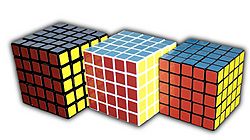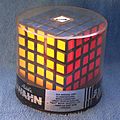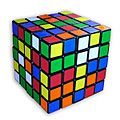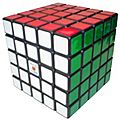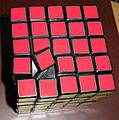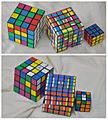Professor's Cube facts for kids
The Professor's Cube is a cool mechanical puzzle. It's like a bigger, trickier version of the famous Rubik's Cube. While the original Rubik's Cube is a 3x3x3 puzzle, the Professor's Cube is a 5x5x5 cube. This means it has more pieces and more ways to get mixed up!
If you already know how to solve the regular 3x3x3 Rubik's Cube or even the 4x4x4 Rubik's Revenge, you'll find that some of those skills can help you with the Professor's Cube. It shares some ideas with both of them.
Contents
What is the Professor's Cube?
The Professor's Cube is a three-dimensional puzzle that challenges your brain. It has five layers on each side, making it much larger than the classic 3x3x3 cube. Each side of the cube has a different color. When you twist and turn the layers, the colors get all mixed up. Your goal is to get all the colors back to their original sides.
How is it Different from Other Cubes?
The main difference is the number of layers.
- The original Rubik's Cube has three layers.
- The Rubik's Revenge has four layers.
- The Professor's Cube has five layers.
This extra size means there are many more pieces to move around. It also introduces new challenges. For example, the center pieces on a 5x5x5 cube can move, unlike the fixed center piece on a 3x3x3 cube. This makes solving it more complex.
Center Pieces and Edge Pieces
On a 5x5x5 cube, the center pieces are not fixed. This means you have to figure out where they belong. The edge pieces are also more complicated. Instead of just one piece, there are three small pieces that make up each edge. You need to group these pieces together correctly before you can solve the cube.
Solving the Professor's Cube
Solving a Professor's Cube often involves a strategy called "reduction." This means you try to make the 5x5x5 cube act like a smaller cube.
The Reduction Method
First, you solve the center areas. You group all the same-colored center pieces together. This creates a solid color block in the middle of each face. Once all six centers are solved, the cube looks a bit like a 3x3x3 cube in the middle.
Next, you pair up the edge pieces. Remember, each edge on a 5x5x5 cube is made of three smaller pieces. You need to bring these three pieces together to form a complete edge. After all the edges are formed, the cube will look and act like a regular 3x3x3 Rubik's Cube.
Final Steps
Once you have reduced the 5x5x5 cube to a 3x3x3, you can use the same methods you would use to solve a standard Rubik's Cube. This makes the big puzzle much less scary! It's a great way to use your problem-solving skills.
History of the Professor's Cube
The Professor's Cube was invented by Ernő Rubik, the same person who created the original Rubik's Cube. It was first released in the 1980s, after the huge success of the 3x3x3 and 4x4x4 versions. People loved the challenge of these puzzles, and the 5x5x5 offered an even bigger brain-teaser.
Related pages
Images for kids
See also
 In Spanish: Cubo del Profesor para niños
In Spanish: Cubo del Profesor para niños


